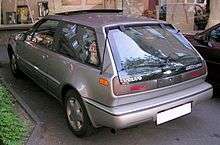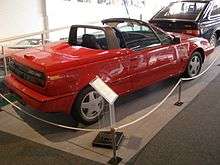Volvo 480
The Volvo 480 is a sporty shooting brake[3] that was produced in Born, Netherlands, by Volvo from 1986 to 1995. It was the first front-wheel drive car made by the automaker. The 480 was available in only one body style on an automobile platform related to the Volvo 440/460 five door hatchback and four door sedan models.
| Volvo 480 | |
|---|---|
.jpg) 1986 Volvo 480 ES | |
| Overview | |
| Manufacturer | Volvo Cars |
| Production | 1986–1995 |
| Assembly | Netherlands: Born (NedCar) |
| Designer | John de Vries (1981)[1] |
| Body and chassis | |
| Class | Compact car (C) |
| Body style | Coupé Shooting brake |
| Layout | FF layout |
| Related | Volvo 440/460 |
| Dimensions | |
| Wheelbase | 2,502.7 mm (99 in)[2] |
| Length | 4,258 mm (168 in) |
| Width | 1,710 mm (67 in) |
| Height | 1,318 mm (52 in) |
| Curb weight | 998 kg (2,200 lb) |
| Chronology | |
| Predecessor | Volvo P1800 |
| Successor | Volvo C30 |
It features an unusual four seat, three door hatchback body, somewhere between liftback and estate in form. The 480 was marketed as a coupé in Europe starting in 1986. The compact car was originally intended to be marketed in the United States as a 2+2 "sports wagon" in the fall 1987, although these plans were cancelled due to the continued weakness of the U.S. dollar during 1987.[4][5][6]
Development
Volvo took six years from the time the 480 was conceived, through its development, and finally brought to production readiness.[2] The press launch was on October 15, 1985, but the 480 was first put on public show in March at the 1986 Geneva Motor Show, becoming available to buyers in May 1986.[7]
The automaker described the car as a four seater with "sporty styling" and the first front wheel driven Volvo.[8] The press described it as having a "sleek hatch body" in contrast to Volvo's traditional "boxcar look".[9] The 480 was the first Volvo of its style since the P1800ES, and the last until the unveiling of the C30.[10] All of these models featured a frameless glass hatch for cargo access.
The 480 was produced in Born, Netherlands, at the factory that built DAF cars, including the DAF 66 based Volvo 66, and later, the Volvo 300 Series. The 480 was the forerunner of the Volvo 440 and 460 models, which were built on the same platform.
Volvo also claimed that it was one of the first cars sold in Europe featuring bumpers designed to comply with United States National Highway Traffic Safety Administration (NHTSA) regulations to withstand a 5-mile-per-hour (8 km/h) front rear impact without damage to the engine, lights, and safety equipment.[11] This was the only Volvo to feature pop-up headlights, this was done to meet NHTSA standards on minimum headlight height while maintaining the aerodynamic shape.[9] However, although it was foreseen to sell 25,000 cars overseas, the introduction of the Volvo 480 to the American market was postponed indefinitely in February 1988, citing unfavourable market conditions and the exchange rate of the US dollar.[12]
The concept was to market a modern, compact front wheel drive car with a unique low slung design targeting buyers "between 25 and 40, probably with a higher than average education and with a career."[2] Designed by Volvo's Dutch subsidiary, the "sporty 480 ES coupe" was introduced to change the automaker's "frumpy image" and into the "yuppie" market segment.[11]
Volvo highlighted that the car was "well-endowed with advanced electronics" and the automaker's press release described in detail the numerous features.[2] The 480 had good handling, due in part to its Lotus designed suspension. The normally aspirated Renault engines were reliable.[13]
Annual changes
The 1987 models were available with an anti-locking brake system (ABS) as an optional extra.[8]
In 1988, a Turbo version was introduced, the Garrett AiResearch turbocharger increasing the power from 109 PS (80 kW; 108 hp) to 120 PS (88 kW; 118 hp). Maximum torque was 175 N⋅m (129 lb⋅ft) compared to the 140 N⋅m (103 lb⋅ft) for the naturally aspirated 1.7 L engine.
In 1993 (United Kingdom), due to new legislation which meant that catalytic converters had to be fitted to unleaded petrol engines, power dropped and so the 2.0 L engine was developed; it was rated at 110 PS (81 kW; 108 hp) and 165 N⋅m (122 lb⋅ft). A four-speed automatic transmission was also offered.
In 1991, the 480 received new mirrors, headrests for the back seats, as well as subtle modifications to the trim and body colour bumpers. The 2.0 naturally aspirated engine was also introduced, again based on the Renault F3 engine.
Changes between the CEM (Central Electronic Module) are externally apparent with the introduction of a total closure system whereby the key can be held in the lock position to close the windows and (where fitted) sunroof. Earlier CEM modules feature a "passing" function for the wipers, whereby fully depressing the accelerator pedal will switch intermittent wipers to full. Early 1992 saw the first release of special editions such as the "TwoTone" (with a two tone paintjob).[14]

1994 saw the United Kingdom release of the "Celebration" limited edition of 480 specially equipped and numbered cars. In 1994, the 480 also received its last light update, and now sported clear front turn signals.[14] Production ended on 7 September 1995. According to the Volvo Museum, 76,375 cars in ES and Turbo versions were made between 1986 and 1995.
Legacy
Writing about the demise of the 480 in Car Magazine, journalist Richard Bremner wrote about the car's decent power and low weight combination. "This meant there was some danger of a sporty steer — pretty radical from a company that considered having fun at the wheel as acceptable as seducing a nun," he commented. "Good grief, a Volvo worth preserving. And there aren't many of them."
He also commented on the last versions for the United Kingdom as, "And Celebration it was too, as Europe waved goodbye to the badly built, pointless, DAF coupé with an outrageous asking price of £16,500. That paid for the CD player, alloys, leather and a pointless hallmarked plaque glued to the dashboard."[13] It "was no sports car" with most being "ridiculously underpowered" and available to collectors "at rock bottom" prices.[13]
Prototypes

The 480 factory also made several prototypes, including a 480 with an electric drivetrain, a supercharged version (G-Lader), a version with a sixteen valve engine, and a version with a turbocharged 2.0 L engine.
A convertible was announced to the press in summer 1987, but not seen in public until the 1990 Geneva Motor Show. It was planned to be launched at the beginning of 1991, but it did not make production after a supplier declared bankruptcy, and concerns over roll over safety protection.[14]
References
- "480 History". www.volvo-480-europe.org. Archived from the original on July 26, 2018. Retrieved October 27, 2017.
- "The Volvo 480 ES: a dynamic car" (PDF) (Press release). Helmond, Netherlands: Volvo Car B.V. 1986. pp. 1, 16–17. Retrieved March 12, 2014.
- {{cite journal |language=en |url=https://drivetribe.com/p/the-volvo-480-Qi_wS3ABTeO__2OGueITlw?iid=Moju9pW4TpGHJzLkZ9kyXw |title=THE VOLVO 480
- "Volvo Cars of North America". Ward's Automotive Yearbook. Ward's Reports. 50: 207. 1988. Retrieved November 4, 2017.
Volvo Cars of North America Inc. was hurt by the continued weakness of the U.S. dollar in 1987, and by U.S. tax law changes that took effect Jan. 1, 1987. The dollar's weakness also caused Volvo to abandon much-ballyhooed plans, slated for the spring of 1987, to import the compact front-drive 480-series cars
- Hartford, Bill (July 1986). "Imports". Popular Mechanics. 163 (7): 49. Retrieved February 19, 2014.
- Matras, John (December 7, 2015). "Volvo 480ES: The immigrant that wasn't". CarBuzzard. Archived from the original on November 7, 2017. Retrieved November 4, 2017.
- Volvo 480ES specifications
- "1980-1989 a historical review". www.media.volvocars.com (Press release) (in German). Volvo Car Corporation. January 8, 2003. Archived from the original on March 13, 2014. Retrieved March 12, 2014.
- "Front Drive Coupe". Popular Science. 228 (2): 46. February 1986. Retrieved September 18, 2018.
- Barry, Keith (May 25, 2011). "Swedish Style Icon Turns 50". www.wired.com. Condé Nast. Retrieved July 26, 2018.
- Scott, David (February 1987). "Dutch treat". Popular Science. 230 (2): 122. Retrieved March 13, 2014.
- Introductie Volvo 480 in VS uitgesteld, Reformatorisch Dagblad, 9 February 1988 (in Dutch)
- Braithwaite-Smith, Gavin (June 20, 2011). "Volvo 480". Bangerwatch. Retrieved February 19, 2014.
- "Volvo 480 historiken" [Volvo 480 history]. Svenska 480 Klubben (in Swedish). Archived from the original on November 2, 2014. Retrieved November 2, 2014.
3 https://drivetribe.com/p/the-volvo-480-Qi_wS3ABTeO__2OGueITlw?iid=Moju9pW4TpGHJzLkZ9kyXw